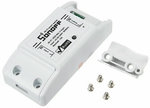Hey folks found this deal in a Banggood email, Seems like a decent price? Not sure if people are still using these or have you all moved up to a better product?
It should come up as $7.02 with shipping and GST just remove the insurance and risk it lol.
Features
.Supports WiFi network.
.Supports status tracking: device status timely provided to the EWeLink.
.Supports remotely turn on or off connected appliance/light.
.Supports max 8 enabled scheduled/countdown/loop timers for each device.
.Supports numerous WiFi smart switches on one smartphone.
.Works with Amazon Echo, Echo Dot, Amazon Tap
.Works with Google Home, Google Home Mini, Google Nest
.Works with IFTTT




Can you use these in Australia yet?